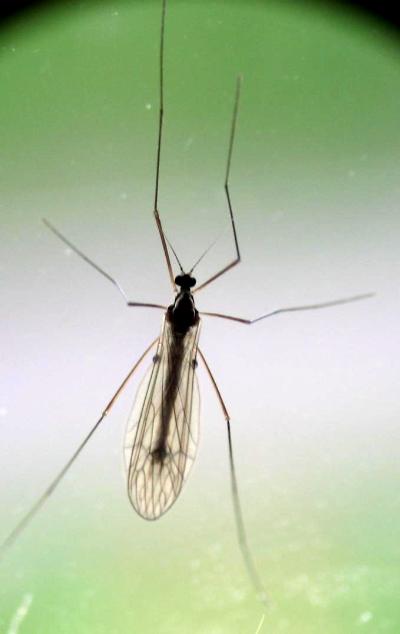Winter Crane Fly
At least, I think it’s a winter crane fly.
Here’s another one from early May of 2007. It was hanging out on our window, and I was able to get a couple of shots in-place before it flew off.

It resembles a mosquito, but it is a bit bigger (the body was about a centimeter long). It’s most likely something in the family Trichoceridae, which are crane flies that are a bit smaller than the huge, gangly things that normally spring to mind when you think of crane flies.
If I’d been a bit quicker, I would have gotten a more current picture of one, because S_ spotted one on the outside of our kitchen window about two weeks ago. Yes, it is February. Yes, I am still in Michigan. There was a bit of a thaw at the time, it was only a little below freezing (rather than a great deal below freezing, like usual in the winter), so they were able to come out. Still, there is a reason why they are called winter crane flies. They aren’t as cold-adapted as the Snow Fly that I posted last year, but they still like things to be a bit on the cool side.
I’d noticed a dark spot on either side of this insect, that at first I thought were markings on the wings. Then I realized that they are actually the “halteres”, which are basically a pair of balls on sticks that they use for balancing when they fly.
The halteres are a characteristic feature of the Diptera, or “true flies”. They only have one pair of actual wings (the front pair), rather than the two pairs that most other insects have. The Diptera are not only very common (including things like house flies, mosquitos, gnats, midges, crane flies, robber flies, and on and on and on), but they are almost universally very strong and highly maneuverable fliers. So, trading in the extra wings to get what are basically guidance gyroscopes looks to have been a good trade for them.
Anyway, I’m basing the ID as “winter crane flies” more on the time of the year than anything else, because once again, I didn’t get pictures good enough to see the veins on the wings clearly. There’s supposedly a particular curved vein up near the shoulders that is characteristic for Trichoceridae, but the image is too dark and insufficiently sharp, and I can’t see it. So, I guess that if that’s something to add to specific items that need to be photographed for proper identification:
(1) For flies, wasps, bees, and other things that have large wings, get a good picture of the wing veins;
(2) For spiders, get a good picture of the eyes and the underside;
(3) For everything else, just try to get pictures of every body part I can think of and hope for the best.
In spite of their mosquito-like appearance, they are not after your blood. The larvae live in decaying vegetation, and I’m not sure that the adults actually eat anything. They may go after plant juices or nectar or pollen, I suppose, but none of those things are available around here until about the middle of May, and certainly not in February. So, there’s a good chance that the adults only last long enough to mate and lay eggs before they starve to death. It’s hard, sometimes, to be an insect.
Comments are closed.



great crane fly info at http://iz.carnegiemnh.org/cranefly
That is a great site. Dr. Young (who created and maintains the site) was the person who identified the snow fly for me.
Another great post. Thanks for sharing! I love the idea of the creature evolving little balls to change its moment in order to maintain balance in flight.